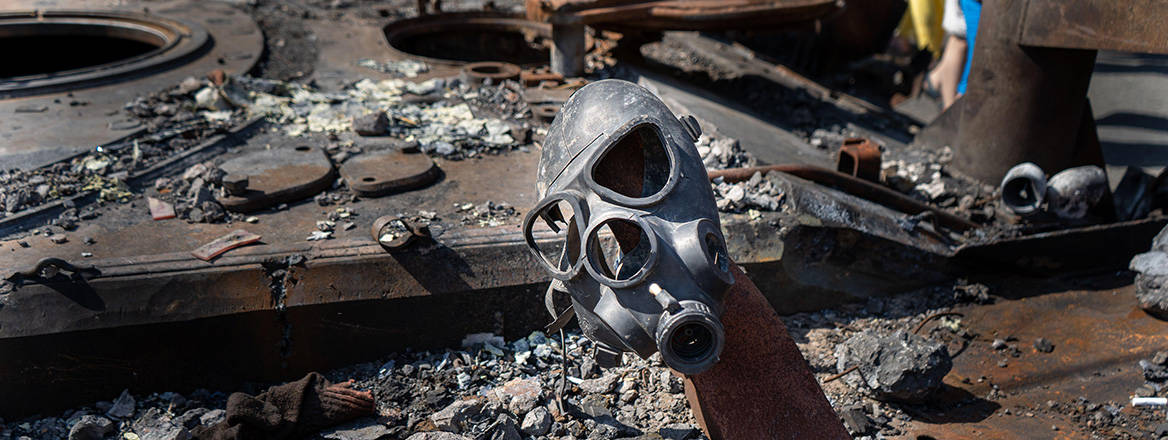Have Chemical Weapons been Used in Ukraine?
Recent reports suggest that Russia has made limited use of riot control agent as a weapon during its war against Ukraine. If true, what might explain this particular use – and what are the prospects of more widescale deployment of chemical weapons by Moscow?
On 2 May 2023, state-controlled Channel 1 reported that Russia has used riot control agent (RCA) as a method of warfare, thus contravening the Chemical Weapons Convention (CWC). Is this the thin end of a wedge, or does it merely represent localised attempts to break a stalemate?
The footage was shown as part of an article that claimed Russian forces had retaken the village of Spirne. The battalion commander, identified as Vladislav Vodolazsky, claimed to have used drones to drop K-51 grenades containing cheryomukha (a type of cherry blossom) onto Ukrainian positions. He referred to the chemical as tear gas, saying it was used to ‘smoke out’ the Ukrainians, who tried to use gas masks to protect themselves but to no avail. It is difficult to ascertain whether or not gas masks were in fact worn, whether they afforded any protection, and whether or not this use of RCA as a method of warfare helped at all in the battle for Spirne. From a technical perspective, RCAs are very simple to protect against, and most modern chemical, biological, radiological and nuclear (CBRN) gas masks will provide more than adequate protection against such incapacitants. However, what this case does show is that not only has the Russian military contravened the CWC, but it has announced this on state-controlled media. Is this significant?
Why Admit to Contravening an International Arms Treaty?
By announcing the action on state media, Russia was telling the world that it does not adhere to the prohibitions of the CWC. Was this merely a test to measure the potential value of escalating use of RCA or even of more toxic chemicals?
Perhaps it was intended to test the waters as to whether there would be international condemnation for breaking the CWC. On the one hand, condemnation may not have a positive impact, as in the eyes of many, RCA is not particularly harmful; thus, highlighting its use as a contravention of the CWC would create noise and subsequently help to normalise the topic, paving the way for escalation. On the other hand, if the international community does not condemn the action as a breach of the CWC, this provides tacit approval for the use of RCA.
Most advanced militaries have protective equipment coupled with defensive training, thus negating any significant benefits that might be gained from the use of chemical weapons
Or was it merely a cynical veiled threat designed to put front line troops on edge, forcing them to worry about exposure to toxic material and to don protective equipment at any possible sign of chemical weapons (CW) use? Only time will tell.
Why Would Military Units be Issued with RCA?
It is a reasonably logical step to go from initial assumptions in early 2022 that the Russian military would take rapid control of the country, to the need to disperse civilian protests and therefore to have ready access to RCA. Although this rapid occupation did not take place, it is also logical that local commanders – who would still have had access to these grenades – would have seen them as a possible game changer in flushing out Ukrainian defenders, adopting the same mentality as in the First World War in an attempt to break a stalemate in entrenched positions. It is quite conceivable that at the time, this use was a local decision, made without local commanders even being aware that use of these weapons was not permitted by the CWC.
It might be argued that the Russian military have these grenades to support training for those tackling the supposed ‘biolabs’ in Ukraine that used to be mentioned regularly by Russian government-affiliated media sources.
But Why Has Russia Not Embarked on Widescale Use of CW?
In making a decision to use CW, ultimately, any perceived advantages would have to outweigh any disadvantages.
In general terms, CW are most effective in situations where people cannot protect themselves against exposure. Most advanced militaries have protective equipment coupled with defensive training, thus negating any significant benefits that might be gained from the use of CW. Both sides would need to don cumbersome CBRN protective equipment, thereby inhibiting operational tempo at the tactical level. From the footage shown on 2 May, it is not possible to see anyone in the trench, let alone the donning of respiratory protection or its subsequent effectiveness. This does not mean there is no information on the subject, which might clarify the effectiveness of protective measures. The ability of Ukrainian troops to defend themselves against a chemical attack would figure significantly in whether or not Russia decided to escalate its use of CW.
On the surface, it would appear that the siege of Azovstal was an ideal situation for using CW, with people underground and thus sheltered from the effects of conventional weapons. However, the value of using a toxic gas diminishes if there is not a way to ensure universal distribution throughout a series of underground passageways. Hence, Azovstal was not the ideal scenario envisioned in April 2022 by Eduard Basurin, a spokesman for Russia's proxies in Donetsk.
Where chemical weapons may be most effectively used is as an agent of terror, particularly against civilian populations who generally are not able to protect themselves
On balance, it is hard to see any significant net advantage for Russia in using CW to clear entrenched positions.
One area where CW may be of value would be the use of a persistent agent for area denial, in particular to slow down a Ukrainian advance – especially when it may not be possible to implement more conventional means of doing so. Depending on weather conditions, agents such as VX or sulfur mustard (HD) could persist for several days or even weeks, requiring the continued use of protective equipment to cross contaminated land in the absence of the ability to decontaminate it. Such a use of CW, however, would not only demonstrate that the Russian declaration to the Organisation for the Prohibition of Chemical Weapons was invalid, but would also provide intelligence on the production processes involved in Moscow’s CW programme. Again, therefore, it is hard to see any net advantage in using CW for area denial, especially when other smart weapon options exist.
Where CW may be most effectively used is as an agent of terror, particularly against civilian populations who generally are not able to protect themselves. Their use in these situations also has the effect of overloading medical facilities with casualties who need treatment, as well as those who are legitimately cautious but may have had minimal or no exposure. Furthermore, targeting the families of fighters can serve as a distraction for the latter, whose focus would subsequently be on the family back home rather than on the immediate conflict in front of them. This targeting of family members appears to have been used successfully in Syria during the Hama offensive in 2017. This was made more effective by the fact that many of the fighters’ families lived in the vicinity of one another. This is less likely to be the case in Ukraine. Denial of critical national infrastructure such as transportation hubs, government buildings and utilities through selective CW use could also have a detrimental effect on longer-term resistance and the ability of Ukraine’s government to remain fully functional – although such a significant escalation would rightly draw much attention and criticism from the UN and the international community.
There appear to be minimal benefits for Russia in using CW in Ukraine, although conversely, there are not many downsides from a Russian perspective either. Negative public opinion certainly does not seem to concern those in the Kremlin, and the use of CW is unlikely to deter supporters of Moscow’s invasion of Ukraine, who already turn a blind eye to allegations of Russian forces breaking international law. Regardless, the indications are that Ukraine is collecting evidence for potential prosecution at the international level.
Perhaps it is much simpler than all this, and the threat of a potential response to Russian CW use by the international community is sufficient – particularly if threats made via backchannels are clearer than those issued publicly.
The views expressed in this Commentary are the authors’, and do not represent those of RUSI or any other institution.
Have an idea for a Commentary you’d like to write for us? Send a short pitch to commentaries@rusi.org and we’ll get back to you if it fits into our research interests. Full guidelines for contributors can be found here.
WRITTEN BY
Lennie Phillips OBE
Senior Research Fellow, Chemical Weapons
Proliferation and Nuclear Policy
Professor David Crouch
RUSI Senior Associate Fellow, Proliferation and Nuclear Policy
- Jim McLeanMedia Relations Manager+44 (0)7917 373 069JimMc@rusi.org



